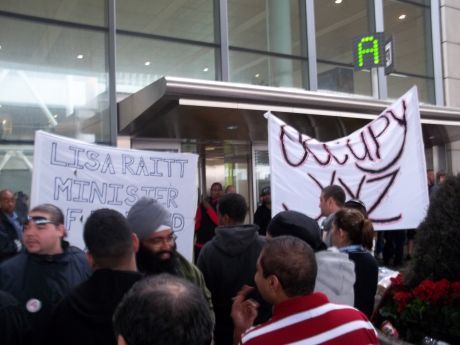Features
You are here
Rediscovering rank-and-file resistance

March 22, 2012
As the the economic crisis deepens, workers are rediscovering different methods of resistance in order to beat back the 1% austerity agenda.
We’re told that the only main tools for improving workers conditions are the ballot box and the bargaining table–that as long as we vote for the labour party, and trust the labour leadership negotiations with the boss, that we’ll be ok. But times are changing.
The crisis of social democracy
Around the world various “left” governments have been elected with the hopes of providing an alternative, only to see them enforce the policies of the 1%. Social democratic governments from Spain to South Africa, and from Greece to Britain have all responded to the economic crisis by making workers pay for it. In Toronto, Mayor David Miller tried to balance the books on the backs of workers, giving rise to the Ford regime.
However well-intentioned social democratic politicians are, they have no control over the economy. While we can vote for once every four years in parliamentary elections, we never get to vote over the most basic economic questions of society—which are determined solely by the whims of the market, and the quest of the 1% for profit. Left leaders have the potential of providing a megaphone for the movement—like when the NDP spoke out against the Iraq War, or in support of postal workers—but the main determinant of political resistance is how well organized ordinary people are in their workplaces, school, and neighbourhoods.
The bargaining table and the employers’ offensive
The self-activity of rank and file workers is also key for economic resistance. Here too, the economic crisis has changed the equation. The employers’ offensive has called into question the trade union leadership’s traditional reliance on simple bargaining.
Multi-billion dollar companies locked out hundreds of workers in London, Ontario and in Alma, Quebec—and in the case of London the company simply stole the plant and moved. In the case of postal workers and Air Canada workers, the company worked hand-in-hand with the Harper government to use back-to-work legislation to force concessions. In the case of Toronto outdoor workers, the union leadership refused to take a strike vote, and then, fighting with one hand tied behind tied behind its back, Ford imposed a brutal contract.
Bureaucracy, Rank and File
Even under “normal” conditions, workers cannot rely on the trade union leadership. By virtue of its position as arbitrator between workers and bosses, the bureaucracy vacillates between concessions and the need to reflect its members.
There can be splits between rightwing and a leftwing trade union leaders, which opens up room for rank and file militancy—like the election of Ontario Federation of Labour president Sid Ryan and the mobilization to London.
What is key is rank and file activity, and there are growing examples of workers taking independent action and building solidarity.
Air Canada machinists and Edmonton hospital workers have staged wildcat strikes.
During the London lockout, autoworkers blockaded in solidarity, during the BC teachers strike BCGEU workers refused to cross the picket line, and there have been sympathy strikes by Air Canada workers in Quebec. In the case of the Rio Tinto walkout, workers in BC have pledged financial support, and there’s an international day of action drawing building for March 31.
Strike like an Egyptian
The past year alone has seen mass strikes from Greece, to Egypt, to Nigeria, to South Africa, to Portugal, to India, and now students in Quebec.
The Egyptian revolution makes this clear that mass working class resistance can not only win economic reforms but raise the hopes for revolutionary change.
As the economic crisis deepens and the 1% goes on the offensive, resistance of rank and file workers is the key.
Section:
- Log in to post comments










